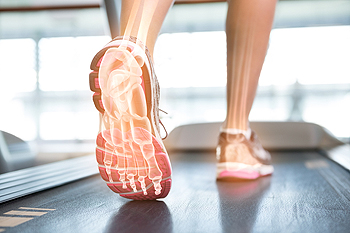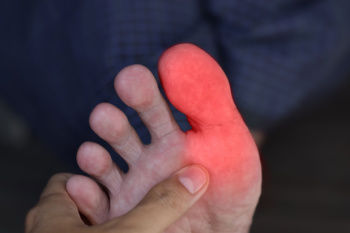Connect With Us
Blog

Preventing and managing running injuries requires a multifaceted approach due to their multifactorial nature. Common risk factors include overtraining, wearing improper footwear, biomechanical imbalances, and inadequate recovery. To mitigate these risks, it is helpful for runners to incorporate a variety of strategies, including proper warm-up and cool-down routines, gradual increases in mileage, strength training, and flexibility exercises. Additionally, ensuring proper footwear selection and addressing any biomechanical issues through gait analysis and orthotic interventions can help prevent injuries. In the event of an injury, treatment may involve rest, compression, elevation, and in some cases, less conservative interventions. If you are a runner and have sustained a running injury, or if you want to make sure you avoid injuries in the future, it is suggested that you schedule an appointment with a podiatrist who can offer expert advice in foot and ankle biomechanics, gait analysis, injury assessment, and customized orthotic interventions.
All runners should take extra precaution when trying to avoid injury. If you have any concerns about your feet, contact Dr. John R. Northrup of Superior Foot, Ankle & Wound Care. Our doctors will treat your foot and ankle needs.
How to Prevent Running Injuries
There are a lot of mistakes a runner can make prior to a workout that can induce injury. A lot of athletes tend to overstretch before running, instead of saving those workouts for a post-run routine. Deep lunges and hand-to-toe hamstring pulls should be performed after a workout instead of during a warmup. Another common mistake is jumping into an intense routine before your body is physically prepared for it. You should try to ease your way into long-distance running instead of forcing yourself to rush into it.
More Tips for Preventing Injury
- Incorporate Strength Training into Workouts - This will help improve the body’s overall athleticism
- Improve and Maintain Your Flexibility – Stretching everyday will help improve overall performance
- “Warm Up” Before Running and “Cool Down” Afterward – A warm up of 5-10 minutes helps get rid of lactic acid in the muscles and prevents delayed muscle soreness
- Cross-Training is Crucial
- Wear Proper Running Shoes
- Have a Formal Gait Analysis – Poor biomechanics can easily cause injury
If you have any questions, please feel free to contact one of our offices located in St. Augustine, and Palm Coast, FL . We offer the newest diagnostic and treatment technologies for all your foot care needs.

Sesamoiditis is characterized by inflammation or injury to the sesamoid bones, small bones located beneath the big toe joint in the foot. It commonly affects individuals involved in activities that put repetitive pressure on the ball of the foot, such as dancers, runners, or those who wear high heels. The condition can cause pain, swelling, and difficulty walking, particularly when bearing weight on the affected foot. Diagnosis typically involves a physical examination, imaging studies like X-rays or MRI scans, and evaluation of symptoms. Treatment options may include rest, taping of the foot, orthotic devices, or corticosteroid injections. In severe cases, surgery to remove or repair the sesamoid bone may be necessary. If you have big toe pain, it is suggested that you schedule an appointment with a podiatrist for a tailored treatment plan for your specific needs.
Sesamoiditis is an unpleasant foot condition characterized by pain in the balls of the feet. If you think you’re struggling with sesamoiditis, contact Dr. John R. Northrup of Superior Foot, Ankle & Wound Care. Our doctors will treat your condition thoroughly and effectively.
Sesamoiditis
Sesamoiditis is a condition of the foot that affects the ball of the foot. It is more common in younger people than it is in older people. It can also occur with people who have begun a new exercise program, since their bodies are adjusting to the new physical regimen. Pain may also be caused by the inflammation of tendons surrounding the bones. It is important to seek treatment in its early stages because if you ignore the pain, this condition can lead to more serious problems such as severe irritation and bone fractures.
Causes of Sesamoiditis
- Sudden increase in activity
- Increase in physically strenuous movement without a proper warm up or build up
- Foot structure: those who have smaller, bonier feet or those with a high arch may be more susceptible
Treatment for sesamoiditis is non-invasive and simple. Doctors may recommend a strict rest period where the patient forgoes most physical activity. This will help give the patient time to heal their feet through limited activity. For serious cases, it is best to speak with your doctor to determine a treatment option that will help your specific needs.
If you have any questions please feel free to contact one of our offices located in St. Augustine, and Palm Coast, FL . We offer the newest diagnostic and treatment technologies for all your foot and ankle needs.
 Ingrown toenails occur when the edge of a toenail, most commonly on the big toe, grows into the surrounding skin. This can lead to pain, redness, swelling, and sometimes infection. This common foot issue can be caused by improper nail trimming, like cutting the nails too short or not straight across. Tight-fitting shoes that press the nail into the toe skin, injury to the toenail, or genetics that predispose someone to curved nails can also contribute to ingrown toenail development. Ingrown toenails can be a cause for concern, especially if they happen frequently or lead to severe pain and infection. If not properly treated, the infection can spread and pose serious health risks, particularly for people with diabetes or poor circulation. Early treatment and certain preventive measures, like proper nail care and wearing appropriately fitting shoes, can help avoid complications. If you have an ingrown toenail, it is suggested that you consult a podiatrist for professional treatment and prevention of further issues.
Ingrown toenails occur when the edge of a toenail, most commonly on the big toe, grows into the surrounding skin. This can lead to pain, redness, swelling, and sometimes infection. This common foot issue can be caused by improper nail trimming, like cutting the nails too short or not straight across. Tight-fitting shoes that press the nail into the toe skin, injury to the toenail, or genetics that predispose someone to curved nails can also contribute to ingrown toenail development. Ingrown toenails can be a cause for concern, especially if they happen frequently or lead to severe pain and infection. If not properly treated, the infection can spread and pose serious health risks, particularly for people with diabetes or poor circulation. Early treatment and certain preventive measures, like proper nail care and wearing appropriately fitting shoes, can help avoid complications. If you have an ingrown toenail, it is suggested that you consult a podiatrist for professional treatment and prevention of further issues.
Ingrown toenails can become painful if they are not treated properly. For more information about ingrown toenails, contact Dr. John R. Northrup of Superior Foot, Ankle & Wound Care. Our doctors can provide the care you need to keep you pain-free and on your feet.
Ingrown Toenails
Ingrown toenails occur when a toenail grows sideways into the bed of the nail, causing pain, swelling, and possibly infection.
Causes
- Bacterial infections
- Improper nail cutting such as cutting it too short or not straight across
- Trauma to the toe, such as stubbing, which causes the nail to grow back irregularly
- Ill-fitting shoes that bunch the toes too close together
- Genetic predisposition
Prevention
Because ingrown toenails are not something found outside of shoe-wearing cultures, going barefoot as often as possible will decrease the likeliness of developing ingrown toenails. Wearing proper fitting shoes and using proper cutting techniques will also help decrease your risk of developing ingrown toenails.
Treatment
Ingrown toenails are a very treatable foot condition. In minor cases, soaking the affected area in salt or antibacterial soaps will not only help with the ingrown nail itself, but also help prevent any infections from occurring. In more severe cases, surgery is an option. In either case, speaking to your podiatrist about this condition will help you get a better understanding of specific treatment options that are right for you.
If you have any questions please feel free to contact one of our offices located in St. Augustine, and Palm Coast, FL . We offer the newest diagnostic and treatment technologies for all your foot and ankle needs.

